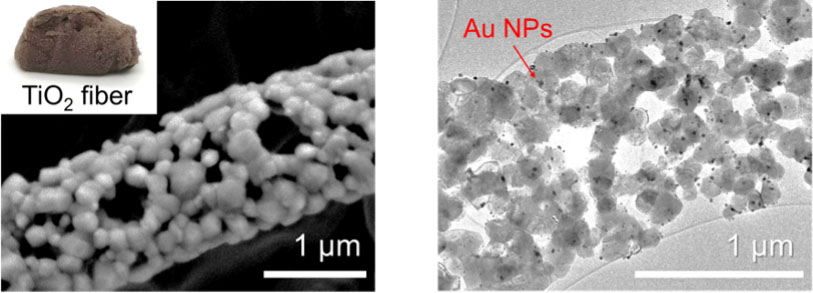| Oct 16, 2023 | |
Reusable nanostructured fibers may boost sustainability of photocatalytic water treatment |
|
| (Nanowerk Spotlight) Providing adequate supplies of clean water is one of the most critical challenges facing the world today. Water scarcity already affects over 4 billion people globally, and with the impacts of climate change and population growth, innovative technologies are urgently needed to improve water purification processes. | |
| Photocatalytic degradation is considered one of the greenest water treatment methods since it harnesses solar energy to destroy pollutants using specially designed catalyst materials. Titanium dioxide (TiO2) is ideal for this purpose, but nanostructured TiO2 has not yet been feasible for industrial-level water treatment partly because the nanopowders cannot be easily recovered after use. | |
| A team from the the Nanomaterials by Design group at Oxford University, led by Professor Nicole Grobert, has developed hierarchically porous titanium dioxide (TiO2) fibers using an innovative fabrication method called dual-polymer templating electrospinning. These fibers, with their strong light absorption resulting in a dark-brown appearance and interconnected macropores for enhanced mass transport, show significant potential for photocatalytic wastewater treatment. | |
| Their findings are detailed in a paper published in Materials & Design ("Hierarchical porosity design enables highly recyclable and efficient Au/ TiO2 composite fibers for photodegradation of organic pollutants"). | |
| Shiling Dong, a Ph.D. student in Grobert’s group, tells Nanowerk that "although the porosity in ceramic fibers has been extensively researched, there are still countless possibilities in manipulating the porous structure, such as our previous work in the direct creation of three-dimensional macroporous ceramic fiber sponges, and herein, the seemingly mystery why we used spherical powder as a template but ended up creating interconnected macropores. It later realized that the polymer template is not only a physical spacer but also introduces chemical etching effects to regulate the crystallization." | |
 |
|
| Scanning electron micrographs and digital photo of the hierarchical porous TiO2 fibers (left) and transmission electron micrographs of the gold nanoparticles (Au NPs)/TiO2 composite fiber. TiO2 fibers have two types of pores: PTFE-templated macropores with 200-500 nm in diameter, and interconnected pores throughout the fiber body with a mean size between 40-80 nm; thus termed hierarchical porosity (image on the left). Because the macropores provide channels for water flow, a facile solution processing method is adopted to homogeneously anchor Au NPs onto the fiber surface (image on the right). (Image: University of Oxford) | |
| The researchers further anchored plasmonic gold nanoparticles (Au NPs) with controllable sizes onto the fiber surface. Benefiting from the plasmonic effect of the homogeneously attached Au NPs, the photoactivity of the Au/TiO2 composite fibers was increased by up to 6.6 times, matching the state-of-the-art TiO2 nanoparticles. | |
| Dr Barbara Maciejewska, Shiling’s co-supervisor in Grobert’s group, points out that "the as-synthesized beautiful nanostructures may show extraordinary properties, but they are not practically useful unless their structural integrity, mechanical stability, and chemical reactivity are properly assessed." | |
| To examine their materials’ recyclability, the researchers used one of the most straightforward approaches to separate the fibers from the treated water, i.e., by natural sedimentation, without centrifugation, filtration, etc. The collected fibers were re-used for five cycles, after which no performance degradation was monitored, and no significant change in morphology and crystalline phases was observed. | |
| In comparison, they applied a similar recycling approach to the TiO2 nanoparticles. Most nanoparticles were dispersed in the water and became non-reclaimable. The materials that were collected were on longer nanoparticles, but their aggregates and welts. | |
| Grobert, with expertise in carbon and non-carbon nanomaterials, notes that "to date, producing high-quality nanomaterials on an industrial scale, at low cost, and in a reproducible manner, remains challenging. Herein, we chose the industrially available electrospinning technique and stayed with a neat component design with less environmental impact and potential hazards, aiming at developing sustainable materials that are easier to be adopted by industries. And the methods herein are highly versatile for applying to other fiber materials." | |
| Developing these hierarchically porous TiO2 fibers represents a significant leap in the field of photocatalytic wastewater treatment, promoting the transformation of photocatalytic technology from bench-scale to industrial application. The researchers continue to explore the possibilities of their newly established synthesis approach, unveiling more innovative materials to address the critical need for cleaner water worldwide. | |
 By
Michael
Berger
– Michael is author of three books by the Royal Society of Chemistry:
Nano-Society: Pushing the Boundaries of Technology,
Nanotechnology: The Future is Tiny, and
Nanoengineering: The Skills and Tools Making Technology Invisible
Copyright ©
Nanowerk LLC
By
Michael
Berger
– Michael is author of three books by the Royal Society of Chemistry:
Nano-Society: Pushing the Boundaries of Technology,
Nanotechnology: The Future is Tiny, and
Nanoengineering: The Skills and Tools Making Technology Invisible
Copyright ©
Nanowerk LLC
|
|
|
Become a Spotlight guest author! Join our large and growing group of guest contributors. Have you just published a scientific paper or have other exciting developments to share with the nanotechnology community? Here is how to publish on nanowerk.com. |
|
